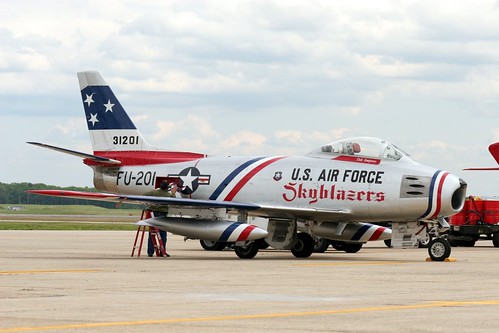North American F-86 airplane
History: In 1944, North American Aviation submitted a design for a swept-wing day fighter which could also be used as a dive-bomber or escort fighter. Two prototype XP-86s were contracted in late 1944, but were not built until after WWII due to the incorporation of several design modifications which were prompted by German research data. The first XP-86 prototype flew on 1 October 1947, powered by a 3,750-pound thrust G.E. J35 engine. After it was re-engined with a more powerful G.E. J47 turbojet the following spring, it was re-designated the YP-86A, and exceeded the speed of sound in a shallow dive. The first production model was initially designated the P-86A, but became the F-86A in June 1948. By the time the new fighter entered US Air Force service in 1949, it had gained the name "Sabre."
Many variants were produced throughout the Sabre's life, the most numerous being the F-86D, an all-weather/night fighter, or which 2,054 were built. In addition to the Sabres built by North American, Canadair Ltd. in Montreal built 60 F-86Es for the US Air Force, plus at least 1,750 Sabre Mk 2/3/4/5/6s for the Royal Canadian Air Force and the Royal Air Force. The later Sabres were powered by various models of the native Orenda engine. Construction of the Sabre was also undertaken by Australia's Commonwealth Aircraft Corporation, which modified the aircraft design to accept two 30-mm Aden guns and a Rolls-Royce Avon 26 engine. Similarly, Fiat in Italy assembled at least 220 F-86Ks from component kits provided by North American, and Japan's Mitsubishi company assembled approximately 300 more.
An offshoot of the F-86 program began when the US Navy and Marine Corps submitted a request for an evaluation variant of the F-86E Sabre, which they designated the XFJ-2 Fury. This new airplane had an arresting hook, an extended nose gear, and a catapult hitch. Later variants of the Fury improved on these features. The FJ-2 had folding wings, the FJ-3 had a deeper fuselage and more powerful engine, and the totally-redesigned FJ-4 and FJ-4B attack aircraft bear only a passing resemblance to their predecessors. [Editor's Note: See our photo coverage of EAA AirVenture 2003 for a photo of an FJ-4 Fury.]
The F-86 saw extensive action in the Korean war, where it was often pitted against the slightly superior MiG-15. Despite the imbalance of capability in their airplanes, Sabre pilots were able to gain superiority over the MiGs. F-86s were exported to many nations around the world, and several live on as target drones, test and research aircraft and, of course, privately-owned warbirds. There is also one privately-owned FJ-4 Fury.
Nicknames: Sabredog; Dog; Dogship (F-86D); Cheesefighter (Dutch F-86Ks, named after the former Amsterdam Superintendent of Police, a Mr. Kaasjager, whose name translated to "Cheesefighter" or "Cheesehunter").
Specifications (F-86D):
Engine: One 7,500-pound thrust afterburning General Electric J47-GE-17B or -33 turbojet
Weight: Empty 12,470 lbs., Max Takeoff 17,100 lbs.
Wing Span: 37ft. 1in.
Length: 40ft. 4in.
Height: 15ft. 0in.
Performance:
Maximum Speed at Seal Level: 707 mph
Ceiling: 45,600 ft.
Range: 835 miles
Armament: 24 69.9-mm (2.75-inch) air-to-air rockets
Number Built: 9,502
